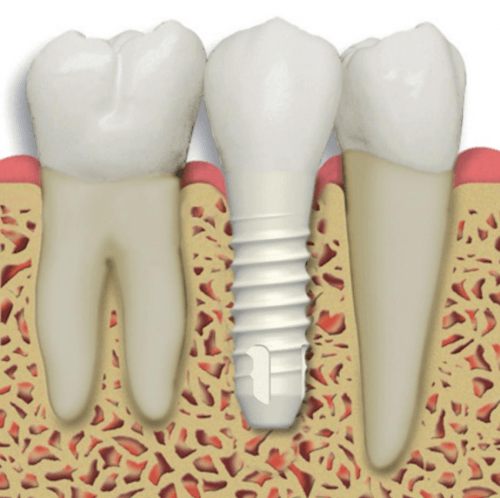
Zirconia vs. Titanium Dental Implants
Zirconia vs. Titanium Dental Implants: Expert Advice from St. Lucie County’s Premier Implant Dentist

Zirconia and titanium implants offer different benefits for patients seeking tooth replacement solutions
Dental implants can affect anyone at any age, and choosing the right implant material is a crucial decision that impacts long-term success. When it comes to dental implant materials, patients in St. Lucie, Stuart, Jensen Beach, and Palm City have important choices to make. As dental implant technology has evolved, the debate between zirconia and titanium implants has become increasingly relevant for those seeking to replace missing teeth with the most suitable, long-lasting option.
At St. Lucie Center of Cosmetic Dentistry, Dr. Hans Almanzar and our team of implant specialists provide expert guidance on implant material selection, ensuring each patient receives personalized recommendations based on their specific oral health needs, aesthetic goals, and lifestyle factors.
This comprehensive guide examines the critical differences between zirconia and titanium dental implants, helping residents of Port St. Lucie and surrounding communities make informed decisions about their implant treatment.
Understanding Dental Implant Materials
The Evolution of Implant Technology in Modern Dentistry
Dental implants represent one of dentistry's most significant advancements, providing a foundation for replacement teeth that look, feel, and function like natural teeth. The implant itself—the component that integrates with the jawbone—is typically made from biocompatible materials that can fuse with bone through a process called osseointegration.
For decades, titanium has been the predominant material used in dental implants, with an extensive track record of success. However, zirconia (zirconium dioxide) has emerged as an alternative that offers certain advantages, particularly in aesthetic areas and for patients with specific concerns about metal in their bodies.
As the premier implant provider in St. Lucie County, our practice stays at the forefront of implant technology, offering both titanium and zirconia options to meet the diverse needs of our patients from Port St. Lucie, Stuart, Jensen Beach, and Palm City.
Key Components of a Dental Implant
- The Implant – The titanium or zirconia post that replaces the tooth root
- The Abutment – The connector between the implant and the restoration
- The Restoration – The visible portion (crown, bridge, or denture)
Titanium Implants: The Gold Standard
Why Titanium Has Been the Material of Choice for Decades
Titanium dental implants have been the industry standard for over 50 years, ever since the discovery of osseointegration by Swedish researcher Per-Ingvar Brånemark in the 1960s. This groundbreaking discovery revealed titanium's unique ability to fuse with living bone, creating a strong foundation for replacement teeth.

Titanium implant with abutment and crown
Advantages of Titanium Implants
- Exceptional Strength and Durability – Titanium implants can withstand powerful biting forces and typically last decades with proper care
- Proven Track Record – With a success rate of approximately 95-98%, titanium implants are backed by decades of clinical research
- Biocompatibility – Titanium rarely causes allergic reactions or rejection
- Versatility – Available in various sizes and designs to accommodate different clinical situations
- Two-Piece Design Options – Most titanium implants feature a two-piece design (implant and separate abutment), allowing for adjustments to optimize aesthetics
- Cost-Effectiveness – Generally more affordable than zirconia alternatives
Potential Drawbacks of Titanium Implants
- Possible Grey Line – In patients with thin gum tissue, a grey line may be visible at the gumline
- Metal Concerns – Some patients prefer metal-free alternatives for personal reasons
- Rare Allergies – Though uncommon, some patients may have sensitivity to titanium or other metals in the alloy
For most St. Lucie County residents, titanium implants remain an excellent choice, particularly for back teeth where strength is paramount and aesthetic concerns are minimal. Our practice uses only the highest-quality titanium implant systems with proven success rates and comprehensive warranties.
After researching my options, I chose titanium implants to replace my missing molars. Dr. Almanzar explained that titanium would provide the maximum strength I needed for chewing. Three years later, my implants are as solid as the day they were placed. I can eat anything I want—even the crunchy foods I avoided for years—and I've never had a single problem.
- Michael R., Port St. Lucie
Zirconia Implants: The Aesthetic Alternative
The Evolution of Metal-Free Implant Options
Zirconia dental implants represent the latest advancement in implant dentistry, offering a metal-free alternative to traditional titanium implants. Made from zirconium dioxide, a white ceramic material known for its exceptional hardness and biocompatibility, zirconia implants have gained popularity among patients seeking the most natural-looking tooth replacement options.

White zirconia implant with matching crown
Advantages of Zirconia Implants
- Superior Aesthetics – The white color of zirconia eliminates the risk of grey showing through thin gum tissue, making it ideal for front teeth
- Metal-Free Option – Perfect for patients with metal sensitivities or those who prefer holistic, metal-free dentistry
- Reduced Plaque Accumulation – Zirconia’s surface properties may attract less bacterial plaque than titanium
- Excellent Tissue Response – Soft tissue adapts well to zirconia, often with reduced inflammation
- Corrosion Resistance – Unlike metals, zirconia will not corrode over time
- Thermal Conductivity – Zirconia does not conduct heat or cold as readily as titanium, potentially reducing temperature sensitivity
Potential Drawbacks of Zirconia Implants
- Higher Cost – Zirconia implants typically cost more than comparable titanium options
- Less Long-Term Data – While promising, zirconia implants have less historical clinical evidence than titanium
- Design Limitations – Many zirconia implants come in one-piece designs, which may limit options in certain clinical situations
- Fracture Risk – Though rare with modern formulations, zirconia implants may have a slightly higher risk of fracture than titanium
Strength and Durability Comparison
How Titanium and Zirconia Measure Up Under Pressure
When considering dental implant materials, strength and durability are critical factors that directly impact long-term success. Both titanium and zirconia offer impressive physical properties, but they perform differently under various conditions.
| Property | Titanium Implants | Zirconia Implants |
|---|
| Tensile Strength | Higher (more flexible) | Lower (more rigid) |
| Compressive Strength | Excellent | Excellent |
| Resistance to Fracture | Very High | Good (improved in newer generations) |
| Fatigue Resistance | Excellent | Good |
| Long-term Stability | Extensively Documented | Promising but Less Data |
Key Insight: Location Matters
The position of the implant in the mouth significantly influences material selection. Molars, which bear the greatest biting forces (up to 200 pounds per square inch), may benefit from titanium's superior strength. Front teeth, which experience less direct pressure but have higher aesthetic demands, may be better candidates for zirconia implants.
Aesthetic Considerations for Front vs. Back Teeth
Achieving Natural-Looking Results with Implant Material Selection
The aesthetic outcome of dental implant treatment is particularly important for residents of Stuart and Jensen Beach seeking to maintain a natural, confident smile. The choice between titanium and zirconia can significantly impact the final appearance of implant restorations, especially in highly visible areas.
Front Teeth Aesthetic Considerations
- Gum Tissue Thickness – Patients with thin gum tissue may see a grey hue with titanium implants
- Smile Line – Patients with high smile lines that reveal the gumline benefit from zirconia’s white color
- Gum Recession Risk – Zirconia may maintain more stable gum levels in some patients
- Light Transmission – Zirconia allows some light transmission similar to natural teeth
Back Teeth Aesthetic Considerations
- Less Visible – Metallic implants are rarely visible in posterior regions
- Functional Priority – Strength typically takes precedence over aesthetics
- Crown Material – The restoration material often matters more than the implant material
DR. ALMANZAR’S AESTHETIC TIP
"For front tooth replacements, we often recommend zirconia implants for patients with thin gum tissues or high smile lines. The white color provides peace of mind that no metal will ever show, even if minor gum recession occurs years later. For patients with thick, healthy gum tissue, both materials can provide excellent aesthetic results when properly placed."
Ready to discuss your implant material options?
Schedule a personalized implant consultation with Dr. Almanzar to discover which material is right for your unique situation.
Call (772) 242-4124Frequently Asked Questions About Implant Materials
Are titanium implants safe for patients with metal allergies?
+
True titanium allergies are extremely rare, affecting less than 0.6% of the population. However, most dental implants use titanium alloys that contain small amounts of other metals. For patients with documented metal allergies or concerns, we offer metal sensitivity testing and zirconia alternatives. At St. Lucie Center of Cosmetic Dentistry, patient safety is our priority, and we carefully evaluate each individual's medical history before recommending an implant material.
Do zirconia implants cost significantly more than titanium?
+
On average, zirconia implants cost approximately 20-30% more than comparable titanium implants. This price difference reflects both higher manufacturing costs and the specialized techniques often required for placement. However, when considering the lifetime value of a dental implant, many patients find that the aesthetic advantages of zirconia justify the additional investment, particularly for front teeth. During your consultation, we provide transparent cost comparisons and discuss financing options to help make zirconia implants accessible for those who prefer them.
How long do zirconia implants last compared to titanium?
+
Titanium implants have a well-documented track record of lasting 20+ years, with many functioning for a lifetime with proper care. While zirconia implants have less long-term data, current research shows promising durability. Modern high-strength zirconia implants are designed to provide similar longevity to titanium, especially when placed by experienced implant specialists like Dr. Almanzar. Both materials can provide decades of service when properly placed and maintained with regular dental care and good oral hygiene.
Can I replace my titanium implant with a zirconia implant if I’m not happy with the aesthetics?
+
While it's technically possible to replace an existing titanium implant with a zirconia implant, it's a complex procedure that requires removing the integrated titanium implant, allowing the site to heal, and then placing a new zirconia implant. This process can take several months and may require bone grafting. It's generally not recommended unless there are medical reasons for removal. Instead, if aesthetic concerns arise with an existing titanium implant, we often recommend exploring solutions like gum grafting or custom abutments to improve the appearance without replacing the implant itself.







